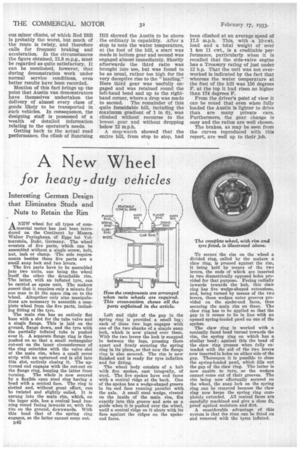A New Wheel
Page 60

If you've noticed an error in this article please click here to report it so we can fix it.
for heavy-duty vehicles
Interesting German Design that Eliminates Studs and Nuts to Retain the Rim
A'
wheel for all types of cora
'mercial motor has just been introduced on the Continent by Messrs. Walter Peyinghaus, of Egge hal yolraarstein, Ruhr, Germany. The wheel consists of five parts, which can be assembled without a single screw, bolt, nut, lash or clamp. The sole require. merits besides these five parts are a small snap lock and two levers.
The five parts have to be assembled gnth two units, one being the wheel Itself the other the detachable rim. The latter, with an inflated tyre, can be carried as spare unit. The makers assert that it requires only a minute for one man to fit the spare Hay on to the 'wheel. Altogether only nine manipulations are necessary to assemble a complete wheel from the five parts, including fitting of the tyre.
The main rim has an entirely flat base with a slot for the tube valve and a single flange. This is laid on the ground, flange down, and the tyre with the partially inflated tube is pushed over it. A separate flange ring is then pushed on so that a small rectangular cut-out on the inner circumference of the ring coincides with the valve slot of the main rim, when a small cover strip with an upturned end is slid into this slot, entirely closing it. The upturned end engages with the cut-out on the flange ring, keeping the latter from turning. The whole is now secured by a flexible open steel ring having a bead with a conical face. The ring is slotted and, without great effort, can be twisted and slightly coiled. It is sprung into the main rim, which, on the inner side, has a conical bead running round facing inwards or, with the rim on the ground, downwards. With this bead that of the spring ring engages, so the latter cannot come out.
B443 Left and right of the gap in the spring ring is provided a small lug; each of these two lugs engages with one of the two shanks of a simple snap lock, which is now placed over them. With the two levers the lock is snapped in between the lugs, pressing them apart and firmly securing the spring ring in its place, so that now the flange ring is also secured. The rim is now finished and is ready for tyre inflation and for fitting.
The wheel body consists of a hub with five spokes, cast integrally, of steel. The five spokes have end faces with a conical ridge at the back. One of the spokes has a wedge-shaped groove In its end face running parallel with the axle. A small steel wedge, riveted on the inside of the main rim, fits exactly into this groove and acts as a guide when it is pushed over the wheel, until a conical ridge on it abuts with its face against the ridges on the spokeend faces. To secure the rim on the wheel a divided ring, called by the makers a claw ring, is pressed against the rim, it being held by means of the two levers, the ends of which are inserted in two diametrically opposed holes provided for that purpose. Facing radially inwards towards the hub, this claw ring has five wedge-shaped extensions, and, being turned by means of the two levers, these wedges enter grooves provided on the spoke-end faces, thus securing the main rim on these. The claw ring has to be applied so that the gap in it comes to lie in line with an opened spring-loaded pawl on one of the spokes.
The claw ring is worked with a conically faced bead turned towards the rim, the spring ring on which has a similar bead ; against this the bead of the claw ring presses when fully extended with the aid of the two levers now inserted in holes on either side of the gap. Thereupon it is possible to close the spring-loaded pawl, which fills out the gap of the claw ring. The latter is now unable to turn, so the wedges cannot come out of their grooves. The rim being now effectually secured on the wheel, the snap lock on the spring ring can be removed because the claw ring now keeps the spring ring completely extended. All conical faces are carefully machined and give a close fit, proof against moisture and dirt.
A. considerable advantage of this system is that the rims can be fitted on and removed with the tyres inflated.




























































































